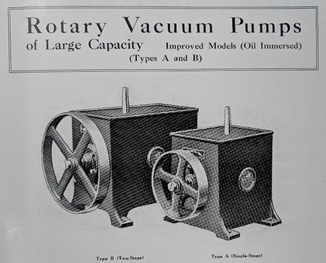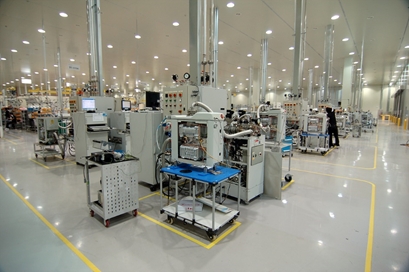BY IAN STONES, Vice President, Technology, Edwards, Burgess Hill, West Sussex, U.K.
Aristotle said, “Horror vacui,” Well, nature may indeed abhor a vacuum, but semiconductor manufacturing certainly does not. Vacuum and abatement are two of the most important functions of the sub-fab. Vacuum pumps evacuate process chambers to provide the clean, low pressure environment required for many processes and remove unused process gas and by-products. These, in turn, are passed to abatement systems where harmful components are removed or transformed so they can be safely disposed of or released. Continuing innovation in these technologies was essential in allowing the industry to maintain the pace of development so famously projected by Gordon Moore decades ago and remains essential now as we look to extend that pace into the future.

Vacuum – enabling advances in science and technology
Vacuum technology played an im- portant role in science and industry long before modern semiconductor devices were invented. A look back at the last 100 years shows a steady stream of evolving applications. Early uses of vacuum included light bulbs (to extend filament life) radios and ampli- fiers (pre-semiconductor electronics was largely based on “vacuum” tubes) and televisions (CRT picture tubes). Vacuum is also widely used in the food and pharmaceutical industries in freeze drying, distillation, packaging and crystallization processes.
In the last decade, we have seen many new vacuum applications emerge and grow, including the production of smart phones, high-brightness LED lighting, photovoltaic solar panels and Li-ion batteries. Taking the example of a modern smart phone, it seems we find the need for vacuum-based manufac- turing processes almost everywhere we look – including advanced semi- conductor processors and memory, MEMS sensors, high resolution LCD/ LED screens, Li-ion batteries, vacuum formed cases and anti-reflective and oleophobic screen coatings. It’s hard to imagine life today without the products enabled by vacuum.

The methods invented for creating a vacuum are almost bewildering in their number and diversity. Entrapment technologies such as cryo-pumps, ion pumps and sorption pumps capture molecules on their internal surfaces and do not require moving mechanical components inside the vacuum space. Positive displacement technologies are mechanical pumps. Most have in common the use of a pumping chamber of variable volume inside the vacuum space, which continuously captures and removes gas from the lower-pressure inlet and compresses and displaces it towards the higher-pressure outlet. Most positive displacement pumps can be conveniently categorized as oscillating displacement (pistons and diaphragms) or rotating displacement (vane, scroll, screw, roots, claw, liquid ring etc.) mechanisms. Kinetic or momentum transfer pumps are also mechanical but operate by imparting momentum (in the direction of the outlet) to the gas as it interacts with the pump surfaces. In the case of a turbomolecular pump, momentum is transferred when gas molecules collide with a series of interleaved, angled blades on a rapidly rotating rotor and a stationary stator. Other kinetic pumping mechanisms include Gaede, Holweck, Siegbahn and regenerative (or side channel) pumps. Often these kinetic mechanisms can be combined on a common shaft to provide wider operating ranges.

The importance of vacuum and abatement to semiconductor processes
Although the integrated circuit (IC) was invented in the mid 1900’s, it was 1970 before the first processors based on familiar CMOS technologies were pro- duced (Intel’s 4004). The manufacturing process, involving the sequential deposition and patterning of multiple layers, was fundamentally the same then as it is now, though minimum feature sizes then measured in the tens or hundreds of micrometers. Then, as now, many process steps required vacuum conditions in the process chamber to prevent interference and contamination by gas molecules present in air. Most vacuum pumps in use at the time were oil-sealed rotary vane pumps.
By the 1980s, integrated circuit production was expanding rapidly, and new processes and increasing gas flows led to problems with aggressive chemicals and solids collecting in the pump oil. Frequent maintenance procedures to change very expensive specialty pump oils interrupted production, reduced productivity and increased cost-of- ownership. In addition, new processes with more stringent requirements for contamination and cleanliness were intolerant of oil back-streaming from the vacuum system.

In 1980, Henry Wycliffe, Edwards’ Chief Engineer, patented the first viable “dry” (oil free) pump. The essence of his invention was the unique and advantageous arrangement of roots and claw mechanisms in a multi-stage configuration that delivered clean vacuum with no need for oil to seal and lubricate the pump. It was quickly adopted by semiconductor manu- facturers and was arguably a critical enabler for the continuing development of increasingly complex semiconductor processes. Continuous innovation ever since has resulted today in a range of dry pumps, each tailored to address the specific challenges of new processes and process chemistries. In many cases, new processes that are now commonplace would not have been possible without major innovations in vacuum and abatement systems.
Significant innovations in addition to the dry pump include:
• magnetically-levitated(maglev)turbo pumps that eliminate mechanical bearings and lubricants to improve cleanliness, extend maintenance cycles and lifetimes and reduce vibration
- special coatings for pump com- ponents that resist attack by harsh process chemicals
- new designs that prevent the accu- mulation of powders or the deposi- tion of condensable gases inside the pump
- green mode operation that reduces energy consumption by putting the pump in a low power mode when the process tool is idle
- advanced abatement technologies that offer extremely high levels of destruction or removal efficiency (DRE) to minimise the environmen- tal impact of the process gases
- fully-enclosed,integratedvacuumand
abatement systems that maximise safety when managing dangerous gases • sophisticated data collection and analysis systems that optimize performance, coordinate maintenance schedules, monitor system health and predict maintenance requirements
New developments in vacuum and abatement technologies have also sig- nificantly impacted the environmental profile of semiconductor manufac- turing. Improving energy efficiency has been a persistent focus. Vacuum pumps alone can represent up to 25% of the total energy consumed by a semi- conductor manufacturing facility. The newest 5th generation semiconductor dry pump, for example, uses less than half of the energy of its predecessor, while providing higher levels of performance, extended service intervals and a much smaller footprint to improve sub-fab space utilization. Similarly, improvements in abatement technol- ogies enable the safe management of ever more challenging gas chemistries. At last reckoning, Edwards’ in- stalled-system base prevents the release of greenhouse gases emissions equiv- alent to approximately 14 million tons of CO2 every year.

100 years of innovation in vacuum and abatement
Physicist F.D Edwards founded Edwards Vacuum in London in 1919. He probably would not recognizethe people, products or locations of the company today, but he would undoubtedly recognize its innovative spirit and the abiding importance of vacuum in industry and technology. Though many of the critical vacuum applications he was so familiar with (light bulbs, CRT TVs, vacuum tubes) have been replaced with completely new technologies (LEDs, flat panel screens, semiconductors), vacuum remains a critical process enabler, and the demand for creative vacuum solutions in new applications is greater than ever. Today his company’s products leverage more than 20 different principles for creating vacuum and abating gas in markets and applications he could not have imagined.
Edwards’ most enduring legacy may be his creation of a company and a culture where innovation thrives. Inno- vation can take many forms. Edwards’ own insight was his entrepreneurial appreciation of a business opportunity. Wycliffe’s was a flash of technical brilliance in combining two disparate technologies in a unique way. Today dedicated teams systematically analyze current needs and future trends to ensure that new solutions will be ready when the industry needs them. End-to-end product roadmaps and intelligent leading metrics allow designers and engineers to measure the relevance and value of new ideas, identify opportunities to optimise the efficiency and effectiveness of new products, and make real-time decisions on development priorities.

The future of vacuum
As we look around our everyday life, it is easy to see some of the pervasive themes driving demand for new and improved solutions, such as the in- creasingly digital content of our world and the seemingly insatiable market demand for intelligent, connected products. It is also more important than ever that we focus on solutions that preserve our environment by improving both energy and material efficiency, and that we support break- throughs in science and technology
in a sustainable and productive way. Though the future is impossible to predict, vacuum will clearly continue to play a critical enabling role. Tech- nology shifts are certain to occur, but the scale and number of applications requiring vacuum will continue to expand, and Edwards will strive to provide the innovative solutions that make those applications possible.